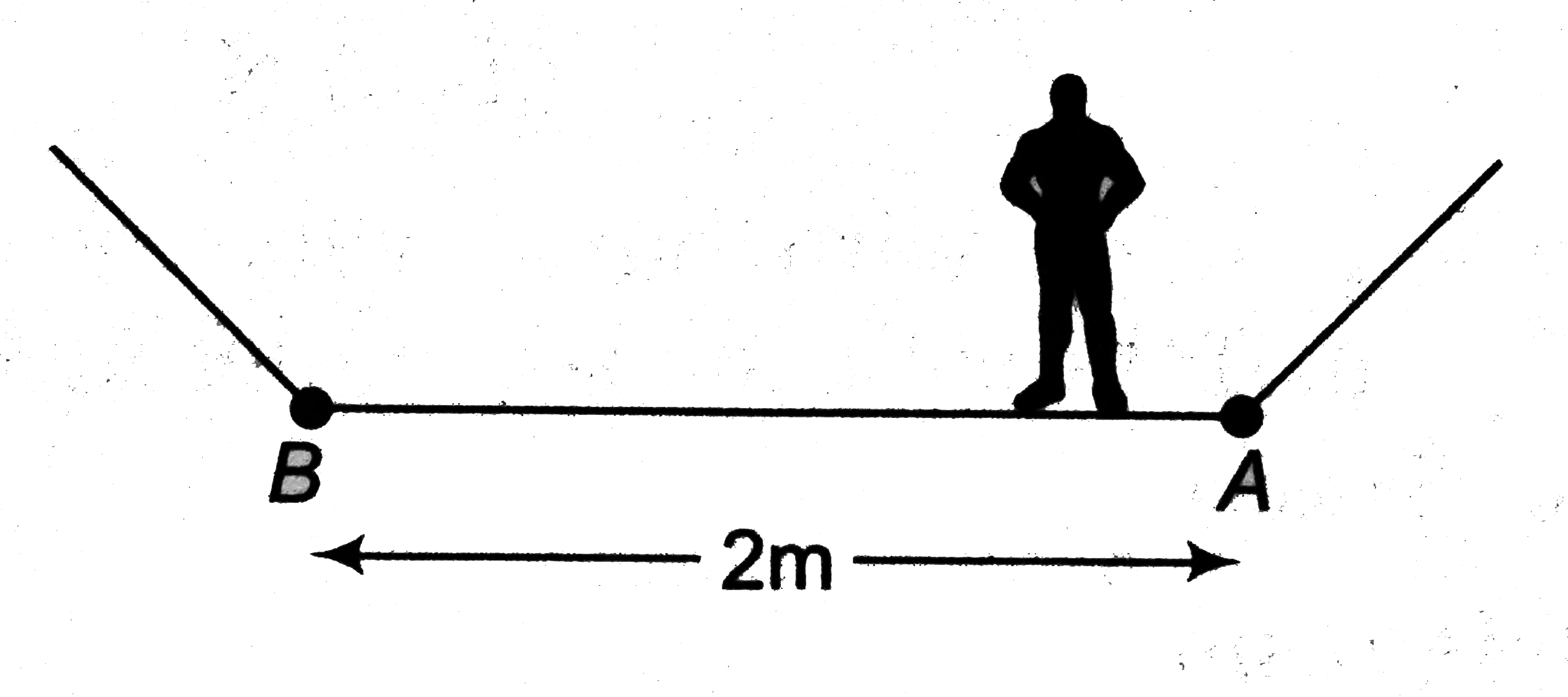A man of is standing at one end on a boat of length and mass .If he starts running and when he reaches the other end, has a velocity with respect to the boat.The final velocity of the boat is
The correct Answer is:A
To solve the problem, we will use the principle of conservation of momentum. Here are the steps to find the final velocity of the boat:
Step 1: Identify the masses and velocities
- Mass of the man (m1) = 50 kg
- Mass of the boat (m2) = 200 kg
- Length of the boat = 25 m
- Velocity of the man with respect to the boat (v_m) = 2 m/s
Step 2: Define the velocities
Let:
- v_b = final velocity of the boat with respect to water
- v_m = velocity of the man with respect to water when he reaches the other end of the boat
Since the man runs from one end of the boat to the other, we can express the velocity of the man with respect to water as:
vm=vb+2m/s
Step 3: Apply the conservation of momentum
Initially, the total momentum of the system (man + boat) is zero because both are at rest:
Initial momentum=0
When the man runs, the momentum of the system must still equal zero:
m1⋅vm+m2⋅vb=0
Substituting the values:
50⋅(vb+2)+200⋅vb=0
Step 4: Expand and simplify the equation
Expanding the equation gives:
50vb+100+200vb=0
Combine like terms:
250vb+100=0
Step 5: Solve for the final velocity of the boat
Rearranging the equation:
250vb=−100
vb=−100250
vb=−25m/s
Step 6: Interpret the result
The negative sign indicates that the boat moves in the opposite direction to the man's running direction. Thus, the magnitude of the final velocity of the boat is:
|vb|=25m/s
Final Answer
The final velocity of the boat is 25m/s in the direction opposite to the man's running direction.
---
- Mass of the man (m1) = 50 kg
- Mass of the boat (m2) = 200 kg
- Length of the boat = 25 m
- Velocity of the man with respect to the boat (v_m) = 2 m/s
Let:
- v_b = final velocity of the boat with respect to water
- v_m = velocity of the man with respect to water when he reaches the other end of the boat
vm=vb+2m/s
Initially, the total momentum of the system (man + boat) is zero because both are at rest:
Initial momentum=0
m1⋅vm+m2⋅vb=0
50⋅(vb+2)+200⋅vb=0
Expanding the equation gives:
50vb+100+200vb=0
250vb+100=0
Rearranging the equation:
250vb=−100
vb=−100250
vb=−25m/s
The negative sign indicates that the boat moves in the opposite direction to the man's running direction. Thus, the magnitude of the final velocity of the boat is:
|vb|=25m/s
The final velocity of the boat is 25m/s in the direction opposite to the man's running direction.
Similar Questions
A boy of mass 30 kg is standing at one end on a stationary boat over a lake. The boat has a mass 70 kg and length 10 m. Now the boy walked to the other end of the boat. Relative to the ground
View SolutionA man of mass 62 kg is standing on a stationary boat of mass 238 kg. The man is carrying a sphere of mass 0.5 kg in his hands. If the man throws the sphere horizontally with a velocity of 12 ms−1, find the velocity with which the boat will move (in magnitude)
View SolutionA man of mass 70 kg is standing at one end of a stationary, floating barge of mass 210 kg. he then walks to the other end of the barge, a distance of 90 meters. Ignore any frictional effect between the barge and the water.
Q. If the man walks at an average velocity of 8m/s what is the average velocity of the barge?
View SolutionA man of mass 70 kg is standing at one end of a stationary, floating barge of mass 210 kg. he then walks to the other end of the barge, a distance of 90 meters. Ignore any frictional effect between the barge and the water.
Q. How far will the barge move?
View SolutionA boy having a mass of 40kg stands at one end A of a boat of length 2m at rest. The boy walks to the other end B of the boat and stops. What is the distance moved by the boat? Friciton exists between the feet of the boy and the surface of the boat. But the friction between the boat and the water surface may be neglected. Mass of the boat is 15kg.

View SolutionA man (mass =50kg) and his son (mass =20kg) are standing on a frictionless surface facing each other , the man pushes his son so that he start moving at a speed of 0.70ms−1 with respect to the man. The speed of the man with respect to the surface is:
View SolutionA girl of mass 50 kg stands on a railroad car of mass 75 kg moving with velocity 20ms−1 . Now , the girl begins to run with a velocity of 10ms−1 with respect to the car in the same direction , as that of the car. The velocity of the car at this instant will be
View SolutionTwo bodies of masses 3 kg and 2 kg are moving towards wach other with 3ms−1 and 2ms−1 respectively. Then velocity of centre of mass is
View SolutionTwo bodies of masses 4kg and 2kg are moving towards each other with 3ms−1 and 2ms−1 respectively. Then velocity of centre of mass is
View SolutionTwo persons A and B of weight 80kg and 50kg respectively are standing at opposite ends of a boat of mass 70kg and length 2m at rest. When they interchange their positions then displacement of the centre of mass of the boat will be :-

View Solution
